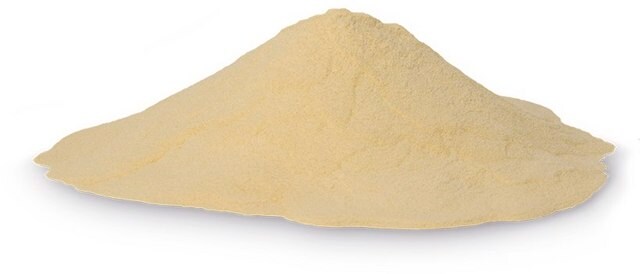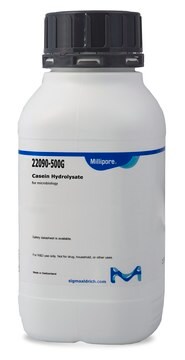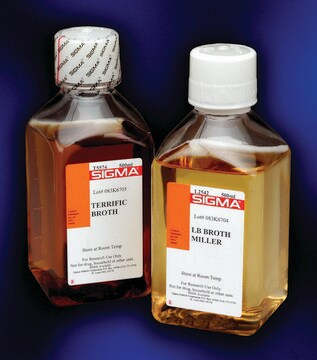N3643
NZCYM Broth
Powder microbial growth medium
Sinônimo(s):
Broth medium
Faça loginpara ver os preços organizacionais e de contrato
About This Item
Código UNSPSC:
41106200
NACRES:
NA.85
Produtos recomendados
grau
Molecular Biology
for molecular biology
esterilidade
non-sterile
Formulário
powder
composição
Casamino Acids, 1 g/L
MgSO4, 0.98 g/L
NaCL, 5 g/L
Tryptone, 10 g/L
Yeast extract, 5 g/L
técnica(s)
microbiological culture: suitable
pH
6.8-7.2(2.2% solution)
aplicação(ões)
food and beverages
microbiology
temperatura de armazenamento
room temp
adequação
nonselective for Escherichia coli
nonselective for coliforms
Descrição geral
NZCYM is a microbial growth medium used for the cultivation of E. coli and lambda bacteriophage. This nutrient-rich microbial broth contains peptides, amino acids, and water-soluble vitamins in a low-salt formulation.
Aplicação
NZCYM Broth has been used for non-selective cultivation of lambda, MS2, T7, CLP-P3, Phi29, and Goe1 bacteriophages, and E. coli strains for cloning, DNA plasmid production, and production of recombinant proteins. It is also suitable for selective cultivation when appropriate antibiotics are added.
Características e benefícios
NZCYM powder provides:
- Standard formulation
- Convenient package sizes
- A budget-friendly alternative to liquid
Reconstituição
Stir to suspend 22 g powder in 1L water. Autoclave for 15 minutes at 121°C to sterilize. Allow to cool before making additions, such as antibiotics (if desired).
substituído por
Código de classe de armazenamento
11 - Combustible Solids
Classe de risco de água (WGK)
WGK 3
Ponto de fulgor (°F)
Not applicable
Ponto de fulgor (°C)
Not applicable
Equipamento de proteção individual
Eyeshields, Gloves, type N95 (US)
Escolha uma das versões mais recentes:
Já possui este produto?
Encontre a documentação dos produtos que você adquiriu recentemente na biblioteca de documentos.
Os clientes também visualizaram
Shane R Wilkinson et al.
The Journal of biological chemistry, 277(19), 17062-17071 (2002-02-14)
Trypanosoma cruzi glutathione-dependent peroxidase I (TcGPXI) can reduce fatty acid, phospholipid, and short chain organic hydroperoxides utilizing a novel redox cycle in which enzyme activity is linked to the reduction of trypanothione, a parasite-specific thiol, by glutathione. Here we show
Bioreagents for Cloning
Sigma data, 2-2 (2011)
Chris Coward et al.
Applied and environmental microbiology, 72(7), 4638-4647 (2006-07-06)
This study characterizes the interaction between Campylobacter jejuni and the 16 phages used in the United Kingdom typing scheme by screening spontaneous mutants of the phage-type strains and transposon mutants of the sequenced strain NCTC 11168. We show that the
Vinni Mona Hansen et al.
BMC microbiology, 7, 90-90 (2007-10-20)
The predominant food borne pathogen in the western world today is Campylobacter. Campylobacter specific bacteriophages (phages) have been proposed as an alternative agent for reducing the burden of Campylobacter in broilers. One concern in relation to phage biocontrol is the
Carla M Carvalho et al.
BMC microbiology, 10, 232-232 (2010-09-03)
Poultry meat is one of the most important sources of human campylobacteriosis, an acute bacterial enteritis which is a major problem worldwide. Campylobacter coli and Campylobacter jejuni are the most common Campylobacter species associated with this disease. These pathogens live
Nossa equipe de cientistas tem experiência em todas as áreas de pesquisa, incluindo Life Sciences, ciência de materiais, síntese química, cromatografia, química analítica e muitas outras.
Entre em contato com a assistência técnica







